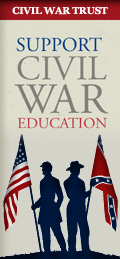Brief Civil War biographies in words and photos fill this moving volume
By Daniel Caplice Lynch
Special to The Eagle
October 10, 2004
Consider 24-year-old Robert Bruce Chamberlin, named after a Scottish hero, late of Pittsfield, Mass., who finds himself one hot day in July standing in front of the largest hole he has ever seen. Destiny calls him. It is 1864, and the union forces have just detonated a mine that has created a hole 170 feet long and 30 feet wide in front of the Confederate entrenchments.
Lieutenant Chamberlin and his comrades advance and the Battle of the Crater in Petersburg, Va., is on. His unit is torn apart. His commander is wounded and captured along with most of the brigade staff: “At the crater, Chamberlin advanced to the enemy’s fortifications when a shell fragment crashed into his head, fracturing his skull. He made it back to the Union line and the corps hospital, where he underwent surgery to remove splintered bone.”
He had not had an easy war. he had already lost his right ear, shot off in North Carolina in March, 1862, and he had been captured in Virginia in September of that year. We are not told how he escaped or whether he was released, but he soldiered on. They raised tough men in Pittsfield in those days.
You can see him in the photograph reproduced in this book. He stands in the photographer’s studio, E.W. Buell of Pittsfield, erect and proud in his long dress uniform with sash and sword and tassels. He is handsome, resolute and confident. Who knew what lay in store for him?
What of Chamberlin after the battle? A month later, his enlistment expired, and he left the army, one would think, by this time, with relief. He married twice, but happiness evidently eluded him: His first wife died, and he divorced his second. Two children died young. He died in 1919 at the age of 78 as the young men returned from another war.
This book exerts a strange fascination. It is made up of 77 photos of Union soldiers, taken by professional photographers as “cartes de visite,” as remembrances, about the size of a Topps baseball card, and left with the folks at home. The cards find their way a century later into flea markets and eBay auctions where the author collects them.
One looks at the photos and tries to guess the futures of these men. Will he storm the barricades and die a hero on the battlefield like Lieutenant-Colonel James F. O’Brien of County Tipperary and the 48th Massachusetts Infantry? He looks out at us, a burly, suntanned man, holding his sword as easily as a hurley.
In an operation called “The Forlorn Hope,” which should have given him a clue as to what was to come, he volunteered to charge the defenses of port Hudson, La. O’Brien was found dead on the most advanced line, leaving behind the grieving wife and six children who wept at his funeral in Charlestown, Mass., beneath the Irish and American flags.
(An aside: My grandmother was an O’Brien from Tipperary and one of her relatives, a Scanlon, fought for the Union at the Battle of the crater. He later returned to Ireland, having had enough of the Yankees and their wars.)
The photo of Pvt. Andrew Jackson Andrews of the 11th Kansas Cavalry shows a man who looks as if he would like to be at peace with all the world. His was not a martial temperament. He deserted three times, just wandering off really, the last time with an Army mule and a couple of horses that led to charges filed against him for stealing. Nothing much happened to him, and he was given a disability pension for his stomach problems which he blamed on his war service, such as it was.
A passion for collecting
Coddington tells us that, even as a kid, traipsing after his parents gone antiquing, he has had a passion for collecting these photos. Lucky for us, they led him to do research on the soldiers’ military service records at the National Archived in Washington, D.C. The Internet provided him with other resources. This, in turn, brought him to write a column for the journal Civil War News called “Faces of War” and then this book, “Faces of the Civil War.”
In addition to the photos and soldier’s biographies, Coddington provides us with extensive notes, a bibliography and a well-organized index, all worthy of the Johns Hopkins University Press.
I recommend this book to all the Civil War buffs out there. Quite a number of the soldiers come from Massachusetts, perhaps because there were many photographers opening up here in the 1860s.
You will find, even if you have no particular interest in military history, that looking into the faces of these men and trying to figure out the body language from across a broad cultural gulf, you are drawn into the book and into a long evening’s reverie.
|
